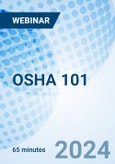Understand the basics of OSHA powers and enforcement initiatives.
When it comes to occupational health and safety, 2024 is shaping up to be a significant year in terms of OSHA enforcement, rulemaking, and new initiatives. As the United States heads into a presidential and congressional election, regulatory activity and enforcement have become a flashpoint politically, potentially threatening the survival of major OSHA activities on the current regulatory agenda.
This session provides a primer on the basics of OSHA powers and enforcement initiatives. It will outline the priorities for the Biden Administration, the forecast for new rules, and the prospects for use of the Congressional Review Act. Pending legislation to abolish the agencies OSHA and NIOSH and rescind the 1970 OSH Act will be discussed, as well as democratic measures to expand OSHA’s authority into the public sector workplace to enhance whistleblower protections and strengthen criminal penalties. The regulatory activities of the Mine Safety & Health Administration (MSHA), impacting contractors at mine sites, including a broad new standard on surface mobile equipment safety, will also be addressed.
This program will capture OHS developments including:
- The December 2023 regulatory agenda, and status of rulemaking activities including workplace violence prevention, heat illness prevention, changes to lockout/tagout, powered industrial trucks, and mechanical power press rules, tree care standards, and progress on infectious disease prevention regulation.
- Updates to OSHA’s whistleblower protection policies
- Enforcement initiatives including SVEP and the IBI (new egregious) citation policy
- New National Emphasis Programs covering warehousing, fall prevention, and heat illness prevention
- The most cited OSHA standards in FY 2023
- ... and more!
Learning Objectives
- You will be able to describe the role of OSHA and other agencies in enforcing workplace safety and health regulations.
- You will be able to recognize the options available to employers after they have been cited by OSHA.
- You will be able to explain the rights every employer has during an OSHA inspection and how they can assert them to increase the chances of a more favorable outcome.
- You will be able to identify the most cited OSHA standards and their significance.
Agenda
Speakers

Adele L. Abrams, Esq., CMSP,
Law Office of Adele L. Abrams P.C.- President of the Law Office of Adele L. Abrams P.C., in MD, CO and WV; www.safety-law.com
- Practice emphasizes all aspects of occupational safety and health and employment law
- Conducts regular seminars and workshops on numerous OSHA, MSHA and human resource issues
- Wrote several publications related to the areas of occupational safety and health and employment law
- Memberships include ASSP, NSC, SHRM and ABA
- J.D. degree, George Washington University; B.S. degree, University of Maryland
- Can be contacted at 301-595-3520, safetylawyer@gmail.com or on Twitter® @Safetylawyer1
Who Should Attend
This live webinar is designed for safety directors, workers’ compensation administrators, human resource managers, business owners and managers, claims and insurance professionals, controllers, bookkeepers and attorneys.









